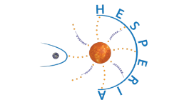Introduction to STEREO REleASE:
STEREO REleASE was developed following the same principles as the original REleASE system (see Posner et al. 2007). About 15 years of data from the STEREO-A High Energy Telescope (HET) and the Solar Electron Proton Telescope (SEPT) were used to create new and improved forecasting matrices for each instruments. As input the 0.125-0.255 MeV SEPT electron channel and the 0.7-4.0 MeV HET electron channel is utilized to predict the 21-40 MeV proton flux. These energy ranges are available in real time as STEREO-A beacon data. Since SEPT uses a Magnet/Foil-technique to measure electrons, proton contamination is possible and can lead to an increased number of false alarms. Therefore an algorithm was developed that can estimate the level of contamination in real time. With that the electron flux can be corrected as long as the contamination level stays below 35%. If the contamination exceeds this limit, the data are not used.
A warning is issued as soon as two consecutive forecasts are above a threshold of 0.22 (s sr MeV cm2)-1. Warnings produced from the SEPT are always crosschecked with the forecasts of the ones from HET and require that these are at least above 0.11 (s sr MeV cm2)-1.
A systematic validation on historic data resulted in a probability of detection of 87%, a false alarm rate of 25% and an average warning time of ~230 min with a median of ~54 min.
STEREO REleASE has been developed through funding from the National Aeronautics and Space Administration under grant agreement No. TXS0150641A (National Observatory of Athens) and No. TXS0150642 (Christian-Albrechts-Universität) and has been built in the open-source programming language PYTHON.
Description of plot:
Both upper row panels show real-time proton fluxes measured by STEREO/HET in the energy range of 21.0 to 40.0 MeV. The next three panels show the proton flux forecasts in 30, 60 and 90 minutes (from top to bottom) obtained with the STEREO REleASE forecasting scheme, based on electron measurements by STEREO/HET (left column panels) and STEREO/SEPT (right column panels), respectively. The bottom-row panels show the respective measured real-time electron fluxes used for the forecasts. The STEREO/HET and STEREO/SEPT electron fluxes cover the energy range of 0.7 to 4.0 MeV and 0.125 to 0.255 MeV, respectively. The thin bar just below the bottom forecast panel of STEREO/SEPT indicates whether contamination exists in STEREO/SEPT electron data (orange lines) or not (blue lines) as described in the introduction above. When contamination exists no forecasts are produced from STEREO/SEPT data. In all proton flux panels, horizontal dashed lines indicate the 0.22 (s sr MeV cm2)-1 proton flux intensity threshold defining significant solar proton events (bottom dashed line), while the top dashed line is shown in order to guide the eye of the user about the peak intensity of the event and whether this crosses the threshold of 10 (s sr MeV cm2)-1. Furthermore, the vertical grey shaded areas within all panels indicate time periods during which the respective electron input data are available.
Historic Data:
Historic data for STEREO REleASE can be found from Data Retrieval Tool (DRT).

 hesperia [dot] info [at] hesperia-space [dot] eu
hesperia [dot] info [at] hesperia-space [dot] eu


